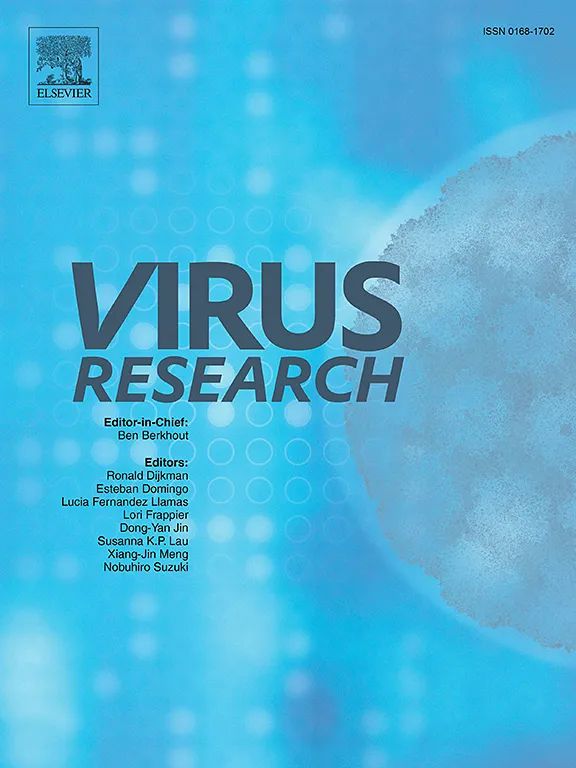Molecular epidemiology and pathogenicity of Wesselsbron virus circulating in Africa
IF 2.7
4区 医学
Q3 VIROLOGY
引用次数: 0
Abstract
Wesselsbron is a neglected, mosquito-borne zoonotic disease transmitted by several species of virus-infected Aedes mosquitoes endemic to tropical regions in Africa. It affects primarily domestic livestock species with teratogenic effects, but can jump to humans. Herein, we investigated the molecular epidemiology of Wesselsbron virus in Africa using whole genome sequencing and structural analysis, and assessed its pathogenicity and tropism through in vivo experiments. A total of twenty-five isolates collected from three countries were successfully characterized. Our study is noteworthy by identifying, for the first time, inter-clade recombination events on the genome of Wesselsbron virus. However, more investigations on the precise molecular mechanisms conducting the occurrence of recombination on the genome of Wesselsbron virus, are warranted. The identification of polymorphisms on motifs of virulence and selection pressures on major proteins showed evidence of genetic evolution for Wesselsbron virus. The clade 1 was more pathogenic and neurotropic in suckling mice and the intramuscular route was found to be the best transmission mode. Our findings also provide new insights in the pathogenicity and tropism of Wesselsbron virus, which could be useful for prevention, preparedness and future outbreak response. Considering its high prevalence in mosquito populations and the increasing number of sporadic human cases, Wesselsbron virus merits more attention in terms of prevention and preparedness, as its mosquito vectors continue to globally expand and there is no vaccine.
在非洲流行的韦塞尔斯布隆病毒的分子流行病学和致病性。
韦塞尔斯布隆病是一种被忽视的蚊媒动物传染病,由非洲热带地区特有的几种受病毒感染的伊蚊传播。该病主要影响家畜,有致畸作用,但也可传染给人类。在此,我们利用全基因组测序和结构分析研究了威瑟布隆病毒在非洲的分子流行病学,并通过体内实验评估了其致病性和滋养性。我们成功鉴定了从三个国家收集到的 25 个分离株。值得注意的是,我们的研究首次发现了威瑟布隆病毒基因组上的支系间重组事件。然而,我们还需要对威瑟布隆病毒基因组发生重组的确切分子机制进行更多的研究。对毒力基因组多态性和主要蛋白选择压力的鉴定显示了威瑟布隆病毒基因进化的证据。支系 1 对乳鼠的致病性和神经侵袭性更强,而且发现肌肉注射途径是最佳传播方式。我们的研究结果还对威瑟布隆病毒的致病性和趋向性提供了新的见解,这对预防、防备和应对未来的疫情爆发很有帮助。考虑到威瑟布隆病毒在蚊子种群中的高流行率以及人类零星病例的不断增加,威瑟布隆病毒值得在预防和准备方面给予更多关注,因为其蚊子载体在全球范围内不断扩大,而且目前还没有疫苗。
本文章由计算机程序翻译,如有差异,请以英文原文为准。
求助全文
约1分钟内获得全文
求助全文
来源期刊

Virus research
医学-病毒学
CiteScore
9.50
自引率
2.00%
发文量
239
审稿时长
43 days
期刊介绍:
Virus Research provides a means of fast publication for original papers on fundamental research in virology. Contributions on new developments concerning virus structure, replication, pathogenesis and evolution are encouraged. These include reports describing virus morphology, the function and antigenic analysis of virus structural components, virus genome structure and expression, analysis on virus replication processes, virus evolution in connection with antiviral interventions, effects of viruses on their host cells, particularly on the immune system, and the pathogenesis of virus infections, including oncogene activation and transduction.
 求助内容:
求助内容: 应助结果提醒方式:
应助结果提醒方式:


